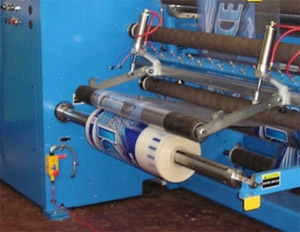

July 17 2017

Today’s web converters are challenged with production requirements that are becoming increasingly difficult to satisfy with the technology of their older slitter rewinder equipment. Roll quality standards are harder to achieve as materials being processed are thinner, have lower modulus and have either very high or very low coefficients of friction or when production speeds and finished roll sizes continue to increase. Modern slitters with improved web handling technologies can make these challenges more manageable. One area where we have seen gains being made in the development of improved lay-on roller systems that help address these process challenges.
As a point of reference, a lay-on roller is a nip, typically non-driven, that remains in contact with a winding package throughout the roll build. They are also referred to as touch, pack, or top riding rollers, and are primarily used to control roll hardness. They do this by metering the amount of air that is entrained into the building roll – pressing harder to squeeze out the air, thus producing a harder finished roll, or pressing lightly to let more air become trapped between the wound layers to yield a softer roll. Today’s lay-on rollers are rather sophisticated but they weren’t always that way. In the beginning, they were quite simple. Let’s look at how this type of equipment evolved over the years.
Pivoting Support Arms
Early versions of lay-on roller systems consisted of a pair of pivoting support arms that simply relied on gravity to apply a nip force based on the weight of the lay-on roller assembly against the winding package. The lay-on roller would start on top of and ride along the outer surface of the roll being wound (hence the name top riding roller) and as the roll’s diameter increased, the lay-on assembly pivoted upwards. As the roller pivots, the angle begins to increase between the vertical force vector from the roller’s weight and the applied nip force, causing the resultant nip force to decrease by the cosine of the angle. Also, the width of the contact patch at the nip point begins to increase as the winding package grows, which results in a decreased contact stress. These natural effects of a gravity-loaded lay-on roller are not always desirable for good wound roll formation. In many cases, the applied nip load must increase during the winding cycle to yield the desired roll structure.
Pivoting Support Arms with Springs
One way to accomplish a good wound roll formation was to attach springs to the support arms to increase the applied nip force as the arms moved through their pivoting path. However, the nip force in either gravity or spring-loaded systems cannot be changed by the operator during the winding cycle without stopping the machine.
Pneumatically Loaded
The advent of pneumatically loaded lay-on roller systems made it possible to make changes on the fly. Not only could the force be changed remotely by the operator, but electro-pneumatic pressure regulators could be programmed to adjust the supply pressure dynamically to give a desired nip load profile based on wound roll diameter. Most machines today are supplied with pneumatically loaded lay-on rollers that offer greater process flexibility than simple gravity or spring-loaded designs. More sophisticated control logic became necessary to control the pneumatic systems in real-time. Proprietary control systems used calculations to predict winding roll diameter and based on the mechanical geometry of the machine, were used to predict lay-on nip force during the winding sequence.
Individual Lay-on Roller Systems
As individual lay-on roller systems evolved from their full-width predecessors, it was necessary to compensate for the changing weight of these lay-on assemblies as the roller lengths changed and this created added complexity and room for error. In a more conventional pivot arm configuration, it becomes very difficult to know precisely how much lay-on nip force is being applied.
Introduction of the Linearly-acting Lay-on Roller
Because of the difficulty of not knowing how much lay-on nip force to apply, linearly-acting lay-on roller systems were developed to provide better nip force control. These designs have the benefit of maintaining a constant nip force for a given air pressure by the nature of their constant geometry.
NEXT ARTICLE IN THE SERIES: Learn more about linearly-acting lay-on roller systems and minimum gap configuration.